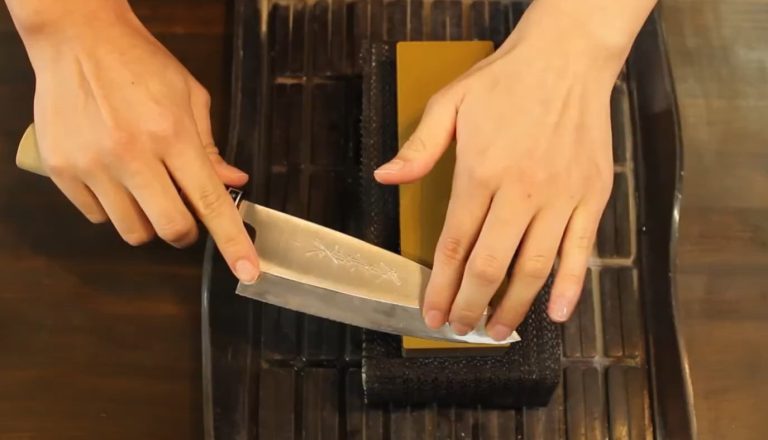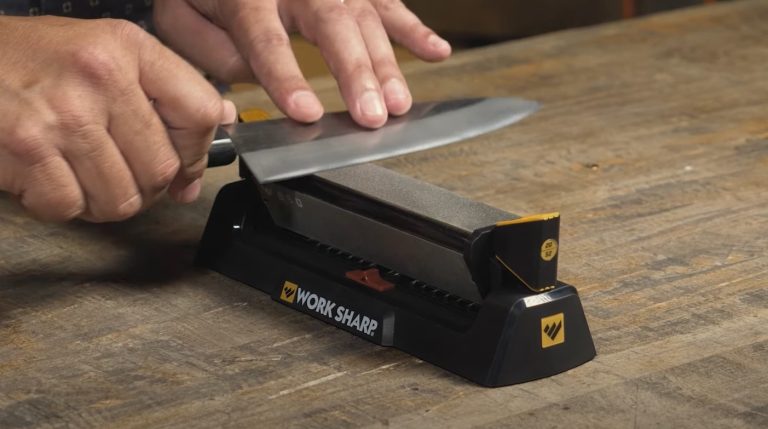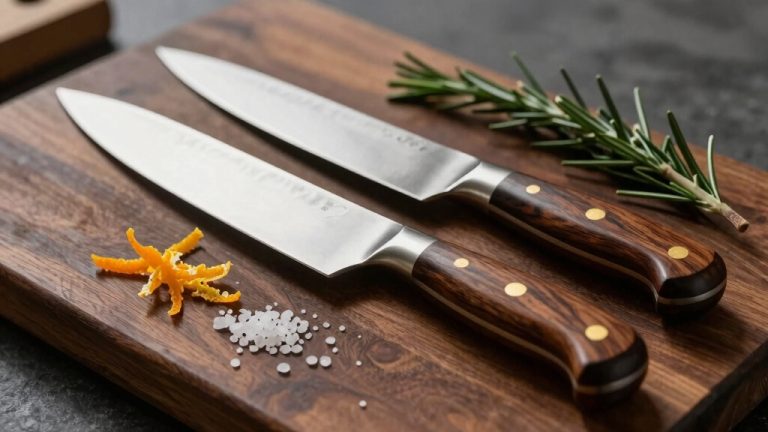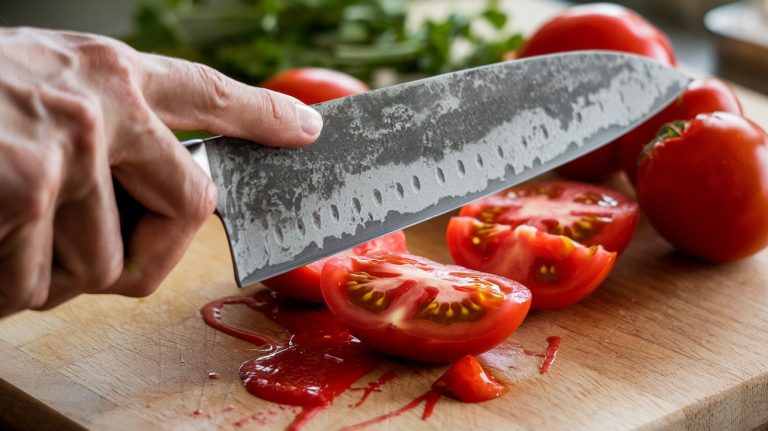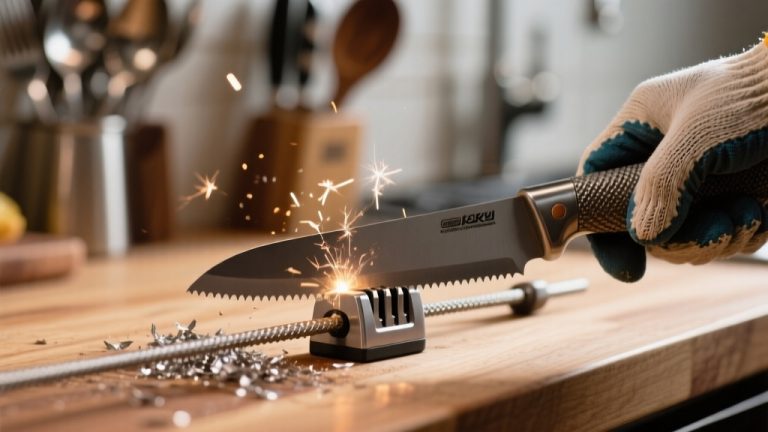How to Use Handheld Knife Sharpener: Sharp, Smooth Edges Every Time
To use a handheld knife sharpener, start by choosing the coarse slot for dull blades, pulling the knife through while applying even pressure.
Use smooth, back-and-forth motions to guarantee consistent sharpening. Afterward, switch to the fine slot for a polished edge. Always clean your knife and sharpener afterward to maintain performance.
Remember, using the right technique is vital for great results. Keep going to discover tips on maintaining your sharpener and improving your sharpening skills.
Key Takeaways
- Begin by selecting the appropriate slot on the sharpener: coarse for dull blades and fine for polishing.
- Hold the sharpener securely on a flat surface and insert the knife blade into the coarse slot.
- Use smooth, back-and-forth motions, applying even pressure to sharpen the blade evenly.
- Once sharpened with the coarse side, switch to the fine slot to refine the edge for a polished finish.
- Clean the knife and sharpener after use to remove any metal shavings and ensure longevity.
Types of Handheld Sharpeners
When you need to keep your knives in top shape, understanding the different types of handheld sharpeners can make all the difference. Pull-through sharpeners are perfect for quick touch-ups, featuring slots for coarse and fine sharpening.
However, the fixed angle of these sharpeners may not suit all knife types. If you have serrated or straight blades, a diamond retractable sharpener offers fine grit precision. For portability, consider mini diamond sharpeners that can attach to your keychain.
Ceramic rod sharpeners provide a compact solution, while traditional Arkansas stone sharpeners allow for precise control. Each type has its unique benefits, catering to various sharpening needs.
With this knowledge, you can choose the best tool to maintain your knives effectively and efficiently, ensuring you always have a sharp edge when you need it.
Benefits of Using a Handheld Sharpener
Using a handheld sharpener not only enhances the longevity of your knives but also brings a host of practical benefits that every home chef can appreciate. Here’s a quick overview:
| Benefits | Details |
|---|---|
| Efficiency | Quick sharpening saves you time in busy kitchens. |
| Portability | Compact design makes it easy to store and transport. |
| Safety | Sharp knives reduce accidents and offer ergonomic handling. |
| Cost-Effectiveness | Maintains knife sharpness, saving money on professional services. |
Regular sharpening maintains optimal knife condition, which is crucial for achieving the best results in your cooking. Additionally, using a handheld sharpener can help you improve cutting efficiency, allowing for smoother and more precise slices.
With these benefits, you’ll enjoy a more efficient cooking experience while ensuring your knives perform at their best. Embrace the versatility and practicality of handheld sharpeners in your culinary endeavors!
Steps to Use a Pull-Through Sharpener
To effectively use a pull-through sharpener, start with the coarse sharpening technique to tackle any dull edges. Regular sharpening keeps knives like new and functional, making your cooking tasks easier and safer.
A well-maintained knife ensures optimal cutting performance in the kitchen. After that, refine the blade on the fine side for a polished finish.
Coarse Sharpening Technique
Start by gathering your materials a pull-through sharpener, a towel to protect your countertop, and optional gloves for safety.
Choose a knife that’s very dull and place it securely on your work surface. Use the coarse slot of the sharpener for heavily damaged blades. It’s recommended to sharpen knives 2-3 times a year for home cooks to maintain their performance.
Grip the knife firmly, pulling it through the sharpener in a smooth, back-and-forth motion. Apply even pressure to guarantee consistent sharpening across the blade’s length, including the tip. It’s important to remember that sharpening removes steel to create a new edge.
You’ll hear a noticeable sound as the sharpener removes steel, indicating effective sharpening. Keep your motion quick, usually just a second or two per pass.
Repeat as needed until you achieve the desired sharpness, but always prioritize safety to avoid accidental cuts.
Fine Edge Refinement
While refining the edge of your knife, achieving a razor-sharp finish is the goal, and a pull-through sharpener makes this process straightforward. First, secure the sharpener on a flat surface to guarantee stability.
Position your knife’s edge with the fine grit slot, keeping the angle consistent for effective results. With light pressure, pull the knife smoothly through the slot, listening for the smoother sound that indicates you’re refining the edge.
It’s important to maintain a proper sharpening angle throughout the process to maximize your knife’s performance. Repeat this motion several times until you reach your desired sharpness.
Regularly honing and sharpening your knives ensures knife performance is maintained over time. Finally, clean your knife with mild soap and dry it thoroughly. This fine edge refinement not only polishes your blade but also removes minor imperfections, assuring your knife is ready for precise cutting tasks.
Regular Maintenance Tips
Maintaining your knife’s sharpness requires regular attention, and using a pull-through sharpener is an effective way to achieve this. Follow these simple steps for ideal results:
- Gather Materials: Confirm you have a pull-through sharpener, a towel for protection, and a honing rod for finishing touches. Manual sharpeners allow for enhanced control during the sharpening process.
- Choose the Right Slot: Select a slot based on your knife type; use coarse for damaged blades and fine for polishing. Using the correct slot selection ensures effective sharpening of your kitchen knives.
- Safe Practice: Wear gloves to protect against cuts while sharpening. Always pull the knife through in a smooth motion, applying even pressure along the entire blade.
After sharpening, clean the knife and sharpener to remove any metal shards.
Common Mistakes to Avoid
Using a handheld knife sharpener effectively requires attention to detail, as common mistakes can lead to disappointing results.
Avoiding these pitfalls will guarantee your sharpening process is both efficient and effective:
- Choosing the Wrong Sharpener: Match your sharpener to the knife type and guarantee you’re using the correct grit.
- Incorrect Technique: Maintain the right angle and pressure; pulling the knife through in the wrong direction can ruin your blade. Starting with a coarse stone helps establish a solid edge before refinement.
- Rushing the Process: Take your time to achieve a sharp edge; rushing can result in uneven sharpening.
Comparison With Other Sharpening Methods
When you compare handheld knife sharpeners to other sharpening methods, you’ll find distinct advantages and disadvantages that cater to different needs. Here’s a quick overview:
| Method | Pros and Cons |
|---|---|
| Handheld | Easy to use, portable, quick results, affordable. |
| Limited precision, less effective for dull knives. | |
| Whetstone | High-quality edge, precise control. |
| Time-consuming, requires skill. | |
| Electric | Fast, consistent results, good for multiple knives. |
| Higher cost, less control. | |
| Rolling | Easy to use, portable, more control than handheld. |
| Less precision than whetstones, durability varies. |
Each method serves specific purposes, so choose one that aligns with your sharpening needs. For example, rolling sharpeners like the Horl 2 offer a smooth experience and high-quality abrasives, making them a popular choice among users.
Proper Storage and Care for Sharpeners
To guarantee your handheld knife sharpener remains effective and lasts longer, proper storage and care are essential.
Store your sharpener in a dry environment to prevent rust and corrosion. Using a protective case or pouch helps shield it from dust and physical damage. Always keep it out of reach of children for safety. Additionally, ensure that you store it wisely to maintain its functionality over time.
After each use, clean the sharpener to remove metal particles, and make sure it’s completely dry before storage to avoid rust. Store it upright to protect the sharpening wheel.
Regularly inspect your sharpener for signs of wear or damage, and avoid overusing it, as excessive wear can reduce its effectiveness.
Frequently Asked Questions
Can I Sharpen Serrated Knives With a Handheld Sharpener?
Yes, you can sharpen serrated knives with a handheld sharpener, but make sure it’s specifically designed for serrations.
Look for a tapered or V-shaped tool that fits into each serration. You’ll need to sharpen each serration individually, which takes more time and precision than sharpening straight-edge knives.
Using the wrong sharpener can damage the serrations, so always choose the right one for the best results.
Regular maintenance will keep your serrated knives effective.
How Often Should I Sharpen My Knives Using a Handheld Sharpener?
You might think sharpening your knives is a hassle, but it’s essential for maintaining their performance.
If you use your knives daily, sharpen them every 2 to 3 weeks. For occasional use, every 3 to 4 months should suffice.
Remember, honing regularly can extend the time between sharpenings.
Pay attention to the tasks you perform; heavy-duty cutting will wear out your blades faster, so adjust your sharpening routine accordingly.
Are Handheld Sharpeners Safe for Beginners?
Yes, handheld sharpeners can be safe for beginners if you follow essential safety precautions.
Guarantee you use a stable surface and hold the knife firmly. Apply controlled pressure while sharpening and always pull the knife away from your body to minimize injury risks.
Wearing cut-resistant gloves and maintaining a clear workspace can further enhance safety.
With practice and the right technique, you’ll sharpen your knives effectively and confidently.
What Materials Are Handheld Sharpeners Made From?
Handheld sharpeners are made from various materials to guarantee performance and durability.
You’ll find plastics in the body for lightweight construction, while metals often form the sharpening stones for effectiveness.
Ceramics can provide precision, and rubber or silicone grips improve handling.
Some models use stainless steel for added durability.
This combination of materials assures that you get a reliable, efficient tool for keeping your knives sharp and ready for use.
Can I Use a Handheld Sharpener on Scissors?
Imagine trying to slice through paper with dull scissors—it’s like trying to cut butter with a rusty knife.
You can use a handheld sharpener on scissors, but not all models are compatible.
Look for one specifically designed for scissors, as they’ll guarantee both blades are sharpened simultaneously.
This can restore their cutting power and make your tasks effortless again.
Just remember to check your sharpener’s guidelines for best results.
Get Your Knives Ready for the Next Cooking Adventure
In summary, using a handheld knife sharpener can keep your blades in tip-top shape, making meal prep a breeze.
Just like your smartphone needs occasional updates, your knives require regular sharpening to perform their best.
By following the steps and avoiding common mistakes, you’ll enhance your technique and guarantee your kitchen tools last longer. So grab that sharpener, and let’s get those knives cutting like they’re straight out of a cooking show.


